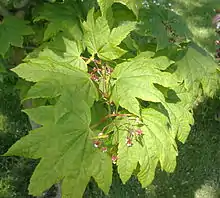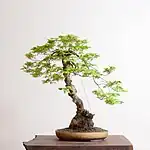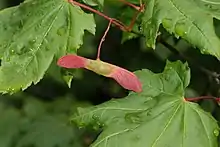Acer circinatum
Acer circinatum, the vine maple, is a species of maple native to western North America. Douglas Maple, a variety of Acer glabrum is also incorrectly called vine maple.[3]
| Vine maple | |
|---|---|
 | |
| Vine maple leaves and flowers | |
| Scientific classification | |
| Kingdom: | Plantae |
| Clade: | Tracheophytes |
| Clade: | Angiosperms |
| Clade: | Eudicots |
| Clade: | Rosids |
| Order: | Sapindales |
| Family: | Sapindaceae |
| Genus: | Acer |
| Section: | Acer sect. Palmata |
| Series: | Acer ser. Palmata |
| Species: | A. circinatum |
| Binomial name | |
| Acer circinatum | |
 | |
| Natural range | |
| Synonyms[2] | |
| |
Description
It most commonly grows as a large shrub growing to around 5 to 8 metres (16 to 26 feet) tall, but it will occasionally form a small to medium-sized tree, exceptionally to 18 m (59 ft) tall. The shoots are slender and hairless.[4][5] The trunk rarely grows more than 25 centimetres (10 inches) thick.[6]
The leaves are 3 to 14 cm (1+1⁄4 to 5+1⁄2 in) long and broad, opposite, palmately lobed with 7 to 11 lobes, almost circular in outline, and thinly hairy on the underside; the lobes are pointed and with coarsely toothed margins. The leaves turn bright yellow to orange-red in autumn. The flowers are small, 6 to 9 millimetres (1⁄4 to 3⁄8 in) in diameter, with a dark red calyx and five short greenish-yellow petals; they are produced in open corymbs of 4 to 20 together in spring. The fruit is a two-seeded samara, each seed 8 to 10 mm (5⁄16 to 3⁄8 in) in diameter, with a lateral wing 2 to 4 cm (3⁄4 to 1+5⁄8 in) long.[4][5][7]
Vine maple trees can bend over easily. Sometimes, this can cause the top of the tree to grow into the ground and send out a new root system, creating a natural arch. This characteristic makes it the only maple capable of layering.
Taxonomy
It belongs to the Palmatum group of maple trees native to East Asia with its closest relatives being the Acer japonicum (fullmoon maple)[8] and Acer pseudosieboldianum (Korean maple). It can be difficult to distinguish from these species in cultivation. It is the only member of the Palmatum group that resides outside of Asia.
Distribution and habitat
It can be found from southwest British Columbia to northern California, usually within 300 kilometres (190 miles) of the Pacific Ocean coast, found along the Columbia Gorge and Coastal Forest.[4][5] It can found no further inland than the east side of the Cascade Range.[6] It typically grows in the understory below much taller forest trees or at the edges of such forests, but can sometimes be found in open ground, and occurs at altitudes from sea level up to 1,500 m (4,900 ft).[4][5]
Ecology
Various birds and mammals eat the seeds of this species.[9]
Cultivation
It is occasionally cultivated outside its native range as an ornamental tree, from Juneau, Alaska,[10] and Ottawa, Ontario,[11] to Huntsville, Alabama,[12] and also in northwestern Europe.[13]
Uses
The Quinault people used the shoots to weave baskets.[6]
Gallery
 Vine Maple bonsai.
Vine Maple bonsai. Flower with reddish calyx and five short petals.
Flower with reddish calyx and five short petals. The fruit is borne in pairs. With wings nearly 180 degrees apart, it is initially green, later becoming reddish (shown) to brown.
The fruit is borne in pairs. With wings nearly 180 degrees apart, it is initially green, later becoming reddish (shown) to brown. Autumn foliage of Acer circinatum.
Autumn foliage of Acer circinatum.
References
- Barstow, M.; Crowley, D.; Rivers, M.C. (2017). "Acer circinatum". IUCN Red List of Threatened Species. 2017: e.T193533A2242484. doi:10.2305/IUCN.UK.2017-3.RLTS.T193533A2242484.en. Retrieved 12 November 2021.
- "Acer circinatum Pursh — The Plant List". www.theplantlist.org.
- Parish, Roberta; Coupé, Ray; Lloyd, Dennis (1996). Plants of Southern Interior British Columbia. p. 73. ISBN 1-55105-057-9.
- Plants of British Columbia: Acer circinatum Archived 2011-06-12 at the Wayback Machine
- Jepson Flora: Acer circinatum
- Arno, Stephen F.; Hammerly, Ramona P. (2020) [1977]. Northwest Trees: Identifying & Understanding the Region's Native Trees (field guide ed.). Seattle: Mountaineers Books. pp. 258–260. ISBN 978-1-68051-329-5. OCLC 1141235469.
- Ashley, A. & Ashley, P. (1990). The Canadian Plant Sourcebook. Cheriton Graphics, Ottawa, Ontario, Canada.
- Li, Jianhua; Stukel, Mark; Bussies, Parker; Skinner, Kaleb; Lemmon, Alan R.; Lemmon, Emily Moriarty; Brown, Kenneth; Bekmetjev, Airat; Swenson, Nathan G. (November 2019). "Maple phylogeny and biogeography inferred from phylogenomic data". Journal of Systematics and Evolution. 57 (6): 594–606. doi:10.1111/jse.12535.
- Whitney, Stephen (1985). Western Forests (The Audubon Society Nature Guides). New York: Knopf. p. 392. ISBN 0-394-73127-1.
- "Downtown Juneau Tree Guide" (PDF). Archived from the original (PDF) on August 18, 2007.
- Buckley, A. R. (1980). Trees and Shrubs of the Dominion Arboretum. Research Branch, Agriculture Canada, Ottawa.
- University of Alabama, Huntsville: Oregon Vine Maple at UAH Arboretum Archived February 24, 2007, at the Wayback Machine
- Rushforth, K. (1999). Trees of Britain and Europe. Collins ISBN 0-00-220013-9.
External links
 Media related to Acer circinatum at Wikimedia Commons
Media related to Acer circinatum at Wikimedia Commons
